Huernia procumbens
Huernia procumbens (R.A.Dyer) L.C.Leach
Family: Apocynaceae
Common names: Limpopo snake plant (Eng.); Limpopo aasblom (Afr.)
Introduction
A procumbent, mat-forming or pendent succulent with rough, 4-ribbed, green to brownish-green, tuberculate stems and star-shaped flowers, with 5 pale, pointed lobes and a chestnut-brown centre, that appear in summer and autumn. Its habitat is in savanna vegetation along the Limpopo River and its tributaries. Best for containers in well-drained soil.
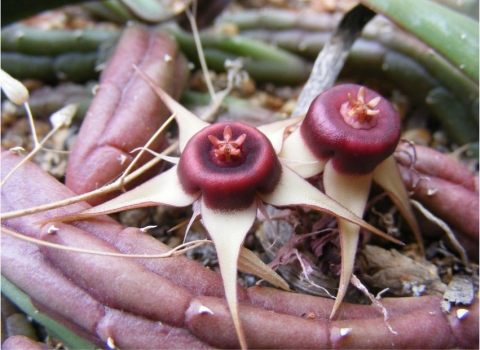
Fig. 1. Huernia procumbens in flower in the Welwitschia House, Kirstenbosch National Botanical Garden.
Description
Description
Huernia procumbens is a succulent plant with brownish green stems, flat-growing (procumbent), mat-forming or pendent from rock faces and up to 500 mm long, often filling crevices and rooting where stems touch the ground. Stems sparingly branched, jointed at attachment, obscurely angular, 4-6 angled, ribbed, about 7-15 mm in diameter, green sometimes purplish mottled, with rudimentary semi-persistent leaves. Inflorescence 3- or 4-flowered, subsessile cymes towards base of stems and lateral branches.
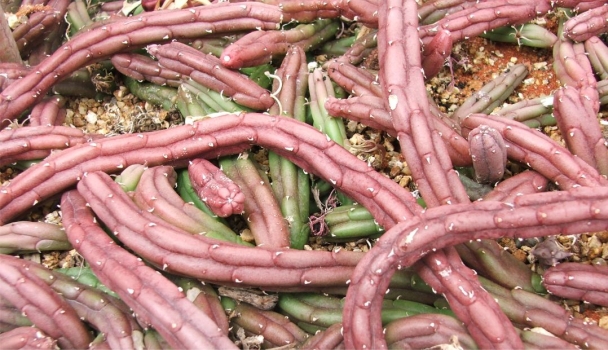
Fig. 2. The mat-forming branches of Huernia procumbens growing in the Welwitschia House, Kirstenbosch National Botanical Garden.
Flowers ascending, opening successively; pedicels short, up to 8 mm long. Corolla star-shaped, 40-55 mm in diameter, with a raised, shortly cylindrical, chestnut-brown annulus, crateriform on the inside, the linear lanceolate lobes spreading widely or becoming recurved, pale cream to cream-white, up to 15-24 mm long, 5 mm wide, the tip drawn to a sharp point (acuminate). Fruit paired fusiform follicles. Flowering is from winter to autumn.
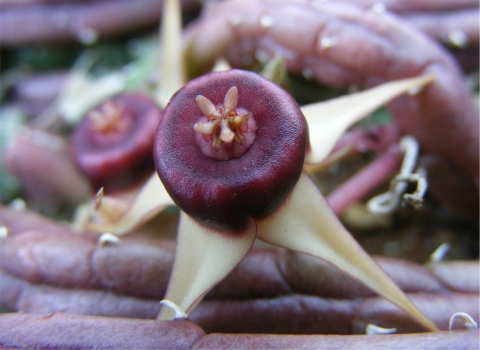
Fig. 3. Close-up of the flower of Huernia procumbens growing in the Welwitschia House in Kirstenbosch National Botanical Garden.
Conservation Status
Status
Huernia procumbens is known from only a few sites, growing on rocky hills or cliffs. It was assessed as Least Concern (LC) in the Red List of South African Plants in 2009 but was reassessed as Vulnerable (VU) in 2019 because it is range-restricted and ongoing degradation of its habitat, caused by overgrazing and over-exploitation of woody species, is causing a decline in its wild population. This species is well established in collections and grown worldwide (ex situ conservation).
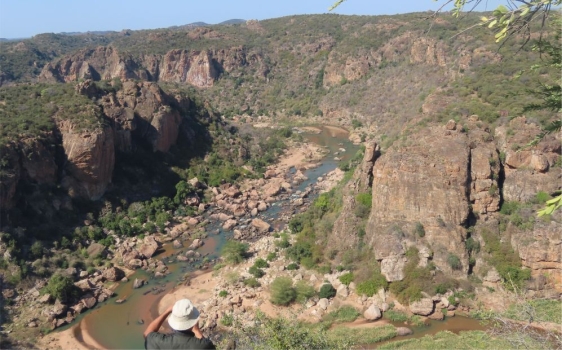
Fig. 4. Lanner Gorge, Levuvu River, Kruger National Park, habitat of Huernia procumbens. Note the basalt cliffs and boulders.
Distribution and habitat
Distribution description
Huernia procumbens is known only from the Limpopo River and adjacent tributaries such as the Lanner Gorge on the Levuvu River in the Kruger National Park. It usually grows among boulders and cliffs at altitudes of about 400-600 m above sea level. The geology is basalt. The climate is subtropical with dry, warm, frost free winters and very hot summers. The rainfall is about 300-400 mm per annum. Plants grow procumbent but become pendent from cliff faces. The habitat is classified as Limpopo Ridge Bushveld which is part of the Savanna Biome (Mucina et al. 2006). At Lanner Gorge, where plants were observed on basalt boulders and cliffs, they share their habitat with species such as Adansonia digitata, Aloe chabaudii, Aloe lutescens, Crassula expansa subsp. fragilis, Euphorbia aeruginosa, Euphorbia rowlandii, Euphorbia tirucallii, Kalanchoe lanceolata, Sansevieria pearsonii, Sansevieria hallii, Gyrocarpus americanus subsp. africanus, Cynanchum viminale, Commiphora edulis, Ficus tettensis, Ficus abutilifolia, Obetia tenax, Tinospora fragosa, Tinospora tenera and Talinum caffrum.
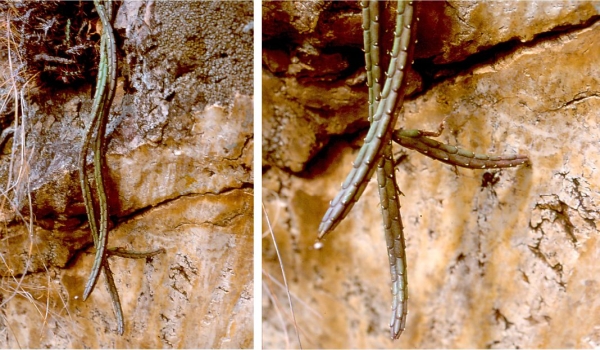
Fig. 5. Huernia procumbens in habitat drooping from a basalt cliff face in Lanner Gorge, Kruger National Park. Here the plant is a cliff hanger, the stems will root when they reach a suitable crevice Note the Euphorbia aeruginosa sharing its habitat (top left).
Derivation of name and historical aspects
History
According to Allen Dyer in his original description of Huernia procumbens, it was first collected and recorded by the Pretoria botanist and director of the Botanical Research Institute from 1963 to 1973, Leslie. E. Codd in 1949. It was later rediscovered by the ecologist H.P. van der Schijff near Pafuri in 1954, flowering in Pretoria in 1955 when it was illustrated by the well-known botanical artist Cythna Letty. The floral shape prompted Allan (R.A.) Dyer to name this plant as Duvalia procumbens in the Flowering Plants of Africa in 1956. Larry Leach, stapeliad expert, realised its rightful place and transferred it to the genus Huernia in the botanical magazine Bothalia in 1969. Allen Dyer was director of the Botanical Research institute in Pretoria from 1944 to 1963 with a keen interest in succulent plants.
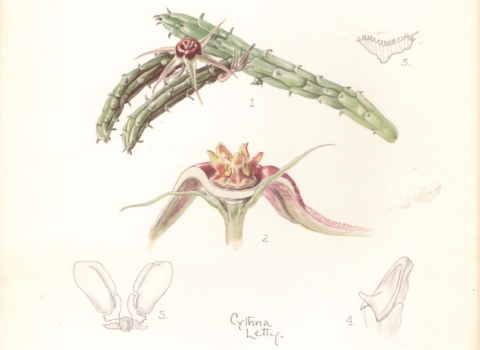
Fig. 6. The type illustration of Huernia procumbens by Cythna Letty, representing the original plant collected by Manie van der Schijff in the Kruger National Park and published in the Flowering Plants of Africa in 1956.
The genus Huernia consists of about 60 species, usually small clustered plants occurring widespread in southern Africa, some with remarkably attractive flowers. The genus Huernia was named by Robert Brown in 1809, honouring Justus Heurnius, a Dutch misionary. Heurnius was responsible for illustrating the first stapeliad, Orbea variegata, from the Cape Peninsula in 1644. The species name procumbens is Latin meaning ‘prostrate’, pertaining to its flat-growing nature.
There are 4 other stapeliad species confined to cliffs in southern Africa the others include Huernia pendula, Tromotriche baylissii and T. choanantha from the south-eastern part of South Africa. Lavrania haagnerae is only known from dolomite cliffs near Sesfontein in Damaraland, Namibia. The latter a cliff hugger with ascending stems. From these Huernia procumbens is immediately distinguished by its ribbed tuberculate stem and pale lobed flowers becoming reflexed. Huernia pendula and the two species of Tromotriche have cup-shaped pendent flowers. Orbea longii is another stapeliad with elongated stems occurring on steep slopes in parts of the Eastern Cape and also on cliffs but not an obligatory cliff dweller. Huernia procumbens is closely related to Huernia tanganyikensis from Tanzania.
Huernia procumbens depicted here was collected at Lanner Gorge, Kruger National Park, in 2003 on an expedition investigating cliffs within the Kruger National Park and adjacent territory. Living plants were introduced to Kirstenbosch National Botanical Garden and later Babylonstoren Farm. They grew rapidly and became mat-forming in the Succulent Nursery at Kirstenbosch growing among Welwitschia mirabilis and Lavrania haagnerae. Living specimens of Huernia procumbens can be seen in the Welwitschia Corner Unit of the Botanical Society Conservatory at Kirstenbosch (, and in the Succulent House at Babylonstoren Farm.
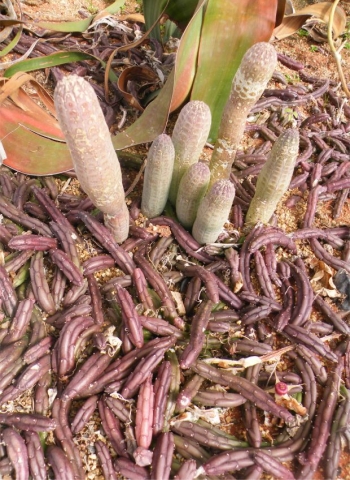
Fig. 7. Huernia procumbens growing as a ground cover in the Welwitschia House. Kirstenbosch National Botanical Garden, with Welwitschia mirabilis and Lavrania haagnerae.
Ecology
Ecology
Plants grow in full sun or dappled shade. The succulent, subterete stems are well adapted to the dry winters and sparse rainfall during summer. The stems turn brownish during dry conditions, when the anthocyanin pigmentation reduces the process of photosynthesis. Its shallow-rooted nature takes advantage of light showers. Plants often grow on bedrock in shallow soil with little competition from non-succulent plants. Stems that are actively growing and lengthening and will occupy new crevices or fissures when finding new ground, establishing new clusters; this is an efficient backup for survival in this dry, hostile environment. Most of the stapeliads have edible stems and plants growing on cliffs escape predation. Huernia procumbens stems are not armed.
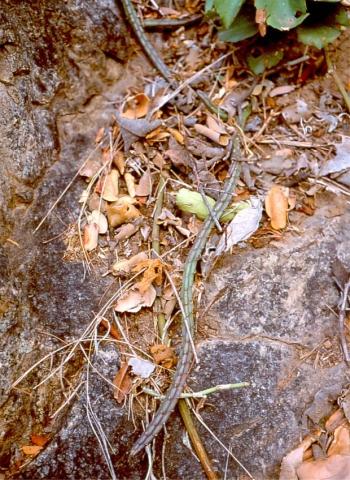
Fig. 8. Huernia procumbens growing on a basalt bedrock ledge, in shallow organic-rich soil at Lanner Gorge, Kruger National Park. Note the wandering stems that will root when reaching a suitable crevice.
The pale creamy lobed flowers are pollinated by insects. Once pollinated, the fusiform paired follicles (fruits) develop, opening when ripe, and the flattened seeds, each seed with its own parachute, are dispersed by gusts of wind , becoming airborne dispersing its offspring. Seeds are released in winter and spring, maximising establishment of seedlings during the rainy season.
Uses
Use
Apart from its popularity as a collector’s item no other uses have been recorded.

Fig. 9. Huernia procumbens growing in the Welwitschia House, Kirstenbosch National Botanical Garden. Note the flower bud and dry, persistent leaf remnants.
Growing Huernia procumbens
Grow
Huernia procumbens is easily grown in dappled shade or full sun and is best for bushveld gardens grown in rockeries (Van Jaarsveld 2010). Outside of its native habitat it is best suited for containers. Plants can be established by planting cuttings in situ. It makes an interesting pot plant, best kept in a partially sunny, exposed position such as a balcony or windowsill. The soil should be sandy (e.g. 2 parts sand, 1 part compost and 1 part garden loam) and well-drained as is found in its natural habitat. They react well to an organic fertiliser. Water sparingly in spring and summer. Keep dry during the winter months.
Sow seed in spring or summer in a sandy medium. First moisten the substrate with fine rose. Sow the seeds and cover lightly with a thin layer of sand. Keep moist and in a shady area. Germination is usually within 2 weeks and the young seedlings are slow growing. Transplant seedlings to individual containers when they are large enough to handle.
Cuttings are best taken in spring or summer. The cutting should first be allowed to dry out, enabling the wound to callus. Place cuttings flat on the ground and plants should root spontaneously.
Plants are relatively disease free.
References
- Albers, F. & Meve. U. (Eds.) 2002. Illustrated handbook of succulent plants: Asclepiadaceae. Volume 4. Springer.
- Bruyns, P.V. 2005. Stapeliads of southern Africa and Madagascar. Umdaus press, Hatfield, Pretoria.
- Court, D. 2010. Succulent flora of southern Africa: Revised Edition. Random House Struik, Cape Town.
- Dyer, R.A. 1971. New and interesting records of African plants: Asclepiadaceae. Distinctions between Duvalia and Huernia. Bothalia 10(2): 363-371.
- Dyer. R.A. 1956. Duvalia procumbens. Flowering Plants of Africa 31: t 1218.
- Gunn, M. & Codd, L.E. 1980. Botanical exploration of southern Africa. Balkema, Cape town.
- Leach L.C. 1988. A revision of Huernia R. Br. (Asclepiadaceae). Excelsa Taxonomic Series 4: 1-197. Aloe, Cactus and Succulent Society of Zimbabwe.
- Leach, L.C. 1969. Stapelieae from south tropical Africa. Bothalia 10(1): 45-54.
- Mucina, L. & Rutherford, M.C. (eds) 2006. The vegetation of South Africa, Lesotho and Swaziland. Strelitzia 19. South African National Biodiversity Institute, Pretoria.
- Raimondo, D., Von Staden, L., Foden, W., Victor, J.E., Helme, N.A., Turner, R.C., Kamundi, D.A. & Manyama, P.A. (eds) 2009. Red list of South African plants. Strelitzia 25. South African National Biodiversity Institute, Pretoria.
- Smith, C.A. 1966. Common names of South African plants. Memoirs of the Botanical Survey of South Africa No. 35. Government Printer, Pretoria.
- Van Jaarsveld, E.J. 2010. Waterwise gardening in South Africa and Namibia. Struik, Cape Town.
- Von Staden, L. 2019. Huernia procumbens (R.A.Dyer) L.C.Leach. National Assessment: Red List of South African Plants version 2020.1. Accessed on 2023/04/27
Credits
Ernst van Jaarsveld
Kirstenbosch National Botanical Garden (Retired 2015)
Babylonstoren Farm
Extraordinary senior lecturer and researcher,
Department of Biodiversity and Conservation, University of the Western Cape
May 2023
Plant Attributes:
Plant Type: Succulent
SA Distribution: Limpopo
Soil type: Sandy, Loam
Flowering season: Late Summer, Autumn
PH: Acid, Neutral
Flower colour: Brown, Cream
Aspect: Full Sun, Shade, Morning Sun (Semi Shade), Afternoon Sun (Semi Shade)
Gardening skill: Average
Special Features:
Horticultural zones







Rate this article
Article well written and informative
Rate this plant
Is this an interesting plant?
Login to add your Comment
Back to topNot registered yet? Click here to register.